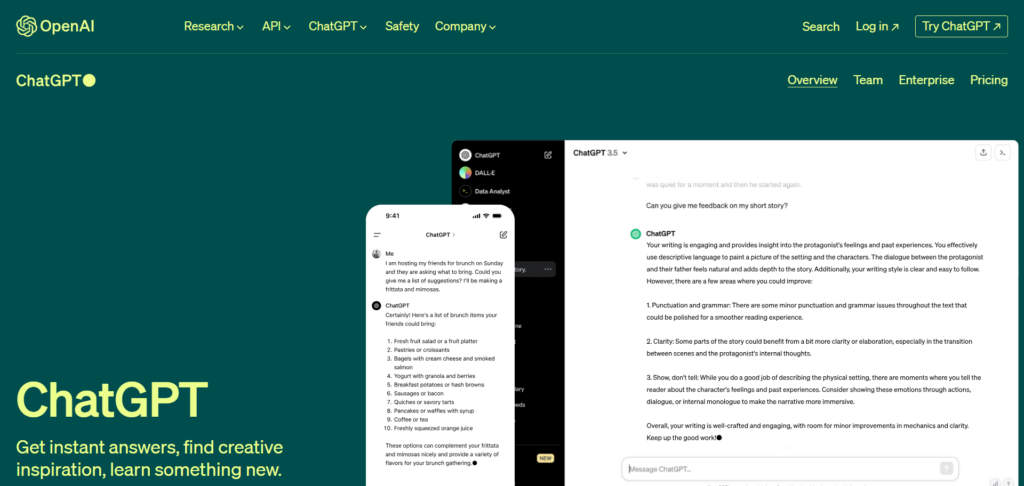Whether you’re drafting reports, crafting stories, or creating content online, writing well is a skill that opens doors. As more professionals search for ways to boost their output and quality, one topic keeps gaining traction: how to use ChatGPT to improve writing. AI writing tools are experiencing significant growth in 2024-2025, with China leading the way at 67% adoption and India following closely at 61%. According to Statista 2024, globally, 71% of organizations regularly utilize generative AI in at least one business function, with companies reporting up to four times faster content creation when these tools are used effectively.
ChatGPT can help you at every stage of writing, from sparking ideas to polishing your style. But here’s the thing: using ChatGPT to improve your writing isn’t about replacing your voice. It’s about making it stronger. Think of AI as your co-pilot, not your autopilot. The real magic happens when you bring your human expertise to the table and let AI support the process.
This guide breaks down how to use ChatGPT for effective writing, offering practical strategies to enhance clarity, creativity, and impact in your work.
Can ChatGPT improve existing text?

You bet it can! Recent research supports the effectiveness of ChatGPT for improving writing. A study from MIT found that using ChatGPT increased the quality of writing tasks by 18 percent. In contrast, another study found that ChatGPT can help novice writers produce work comparable to that of skilled colleagues. User satisfaction rates consistently range between 72% and 80%, with 77% of enterprise users planning to increase their investments in AI writing.
Academic Writing Improvements
Studies show that students who use ChatGPT for writing tasks experience improved grammar, increased coherence, and enhanced readability in their essays. For example, Kasneci et al. (2023) found that high school and university students produced texts with fewer grammatical errors and more logical structure after incorporating AI-generated feedback. Teachers also noticed higher engagement and more meaningful revisions from students using these tools.
EFL (English as a Foreign Language) Student Outcomes
Research by Lee (2023) and Wu et al. (2023) confirms that EFL students benefit from AI writing assistants through fewer grammar and spelling mistakes, improved fluency, and more natural academic language in their revised drafts. These studies highlight that students feel their writing becomes more professional and complete when supported by AI tools.
Professional Content Quality
Industry reports, such as those from the Content Marketing Institute (2023) and McKinsey & Company (2023), show that companies adopting AI writing tools see improvements in content quality metrics, including readability and engagement. These benefits are most effective when AI-generated content is reviewed and edited by humans to ensure accuracy and appropriateness.
Sample prompt for improving existing text
You are tasked with improving an existing text to enhance its readability, ease of reading, and overall structure. This means making the text more accessible and engaging for readers while maintaining its original meaning and intent.
Here is the original text:
<original_text>
{{ORIGINAL_TEXT}}
</original_text>
Follow these steps to improve the text:
1. Carefully read and analyze the original text, paying attention to its content, tone, and intended audience.
2. Identify areas where the text can be improved in terms of:
a) Clarity
b) Sentence structure and length
c) Paragraph organization
d) Use of transitional phrases
e) Active voice usage
f) Conciseness
g) Logical flow of ideas
3. Rewrite the text, focusing on the following guidelines:
a) Use clear and concise language
b) Vary sentence length and structure for better rhythm
c) Organize ideas into well-structured paragraphs
d) Use appropriate transitional phrases
e) Favor active voice over passive voice when possible
f) Eliminate unnecessary words and redundancies
g) Ensure a logical progression of ideas
4. After rewriting, provide your improved version of the text within <improved_text> tags.
5. Explain the changes you made and how they enhance readability, ease of reading, and structure. Include this explanation within <explanation> tags.
Remember to maintain the original meaning and intent of the text while making these improvements. The goal is to make the text more accessible and engaging without altering its core message or tone.
ChatGPT works best when you treat it as a collaborative partner. Context is everything. You need to provide valuable insights through your research, understanding of the audience, and clear goals to achieve meaningful results.
Master Effective Prompting Techniques

Prompting is a skill, and most people take shortcuts with it. Research from Vanderbilt University highlights a huge gap between basic prompting (yielding “B-minus results”) and truly effective prompting (delivering “A-plus work”). You can’t drop a vague one-liner and expect gold.
The Foundation of Better Prompts
Clarity and specificity aren’t optional. Instead of asking,
“How can I write better?”
try,
“What are three techniques to make my product descriptions more persuasive for e-commerce customers?”
The more precise your question, the more targeted and valuable the response.
Structure your prompt like you would an assignment to a freelancer:
- define the persona (who the AI is),
- provide the context (who you’re, what you’re creating, and for whom), and
- set the mission (what it should accomplish).
Advanced Prompting Patterns That Work
The Persona Pattern
Have ChatGPT adopt a specific role or perspective. Format: “From now on, act as [persona]. Pay close attention to [specific focus]. Provide outputs that [persona] would regarding the input.” Fiction authors can use this to develop characters, while business writers can adopt expert perspectives.
The Question Refinement Pattern
Let ChatGPT Enhance Your Initial Questions. Ask: “Can you suggest a better way to phrase this question to get more helpful results?” This turns the AI into your prompting coach.
Contextual Loading
Include substantial background information, constraints, and examples. The more ChatGPT knows about your goals, audience, and requirements, the better the output becomes.
Essential Best Practices
Start with precise action verbs, such as “write,” “explain,” or “analyze,” to set a clear direction. Specify the desired format (e.g., bullet points, paragraph form, step-by-step guide) and include any relevant constraints. Break complex requests into smaller, manageable parts rather than overwhelming the AI with everything at once.
Don’t expect a single “magic prompt” to produce perfect articles. It doesn’t exist. Great AI writing happens in stages. Break your process into research, outline, introduction, body, and conclusion, prompting accordingly. Chain them together logically and fine-tune along the way.
“Most teams ask AI to generate. Smart ones ask it to evaluate. That’s where the real breakthroughs begin. Better yet, use ChatGPT to help improve your prompts.
Tom Winter | CGO SEOwind
Ask what’s missing, what else it needs, or how it could be phrased more effectively. This back-and-forth approach transforms your prompting skills over time.”

Strategic Integration Across Your Writing Process

Using ChatGPT effectively involves understanding its role at each stage of the writing process. The AI excels when you know precisely when and how to leverage it throughout your workflow.
Use ChatGPT to Generate Ideas and Preliminary Research
ChatGPT shines as a brainstorming partner and research assistant rolled into one. For research integration, ChatGPT saves significant time by providing solid starting points. ChatGPT can assist in literature review, data analysis, and writing entire sections of academic papers, while generating plain language summaries from abstracts to make complex research more accessible.
Advanced brainstorming techniques:
Prompt ChatGPT to think like your target audience
One of the most powerful ways to use ChatGPT is having it simulate your target audience’s perspective. This helps you better understand their needs, preferences, and pain points. For example, you could ask:
“Pretend you’re a busy working parent looking for quick, healthy meal ideas. What are your main concerns, and what kind of content would you find most helpful?”
This approach can provide valuable insights into your audience’s mindset, helping you tailor your content more effectively.
Ask it to create a “what if” scenario
ChatGPT creative writing prompts are especially useful for generating “what if” scenarios that can spark your imagination and lead to unique story ideas or thought-provoking articles. Try prompts like:
“What if social media suddenly disappeared overnight? Describe the potential societal impacts and how people might adapt.”
Such scenarios will help you explore novel concepts and create engaging content that captivates readers.
Have the AI play a character
Another interesting technique is to have ChatGPT assume the role of a specific character or persona. This can provide a great deal of value for fiction writers or when creating marketing personas. You might input the following prompt:
“You are a 17th-century pirate captain. Describe your typical day at sea and the challenges you face.”
This method can help you develop rich, authentic characters or gain unique perspectives on various topics.
Ask for analogies and metaphors
Analogies and metaphors can make your writing more vivid and help explain complex concepts. Unsurprisingly, ChatGPT can help develop high-quality examples. Try something like this:
“You are tasked with creating analogies to explain a complex technological concept to a non-technical audience. Your goal is to make the concept more accessible and understandable through relatable comparisons.
The concept you will be explaining is:
<concept>
{{CONCEPT}}
</concept>
To complete this task, follow these guidelines:
1. Create five unique analogies that explain different aspects of blockchain technology.
2. Each analogy should be relatable to everyday experiences or objects that a non-technical person would understand.
3. Ensure that each analogy highlights a key feature or principle of blockchain technology, such as decentralization, transparency, immutability, or distributed ledger.
4. Keep the explanations simple and avoid using technical jargon.
5. Make sure each analogy is distinct from the others and offers a fresh perspective on the concept.
Provide exactly five analogies, numbered from 1 to 5.
Format your response as follows:
<analogies>
1. [First analogy]
2. [Second analogy]
3. [Third analogy]
4. [Fourth analogy]
5. [Fifth analogy]
</analogies>
Remember, your audience is non-technical, so focus on creating clear, easy-to-understand comparisons that illuminate the core principles of blockchain technology without delving into complex technical details.”
While ChatGPT prompts can be incredibly helpful, they’re meant to inspire and assist with your writing, not replace your creativity. Use these ideas as springboards for your own unique thoughts and perspectives. Experiment with different ChatGPT prompts and find what works best for your specific needs and writing style.
Use ChatGPT to Write with Precision
When it comes to drafting your content, writing with ChatGPT can be a game-changer. The tool helps structure your thoughts, explore new writing techniques, and create more polished drafts in less time. Here are some ways to use ChatGPT to write with precision and efficiency.
Drafting and Structure with ChatGPT
When drafting, use ChatGPT to overcome specific challenges rather than expecting complete automation. Create comprehensive outlines by providing your topic, target audience, and desired article length:
Create a detailed outline for a 2000-word article on sustainable fashion for millennials. Include main sections, subsections, and suggested word counts.”
Remember to give as much context as possible. The more details you provide the better structure and outline will be.
Write and Refine with Precision
The most powerful ChatGPT applications often happen in refinement and editing. This AI tool proves invaluable for polishing work and enhancing clarity, style, and overall impact across different writing contexts.
Vocabulary Enhancement and Style Refinement
ChatGPT excels at finding precise alternatives and expanding vocabulary options. Instead of settling for the first word that comes to mind, explore better choices:
“Give me five alternatives to ‘interesting’ that would work well when describing innovative technology solutions.”
For context-specific improvements, include surrounding sentences:
“In this paragraph about customer service, what’s a more professional alternative to ‘fix the problem’?”
This approach ensures suggestions fit naturally within your existing text.
When sentences don’t quite hit the mark, ChatGPT helps explore different expressions. Paste your original content and specify the desired change:
“Rewrite this paragraph to be more engaging for young professionals while maintaining the key information.”
Brand Voice and Tone Consistency
Developing and maintaining a consistent brand voice proves crucial for effective audience communication. Feed ChatGPT examples of your writing style, tone, and typical language, including your style guide, if available.
Create prompts that reflect your brand’s specific characteristics. For a friendly, approachable brand:
“Rewrite this product description in a warm, conversational tone that makes readers feel like they’re chatting with a knowledgeable friend.”
For professional brands:
“Transform this introduction to convey expertise and trustworthiness suitable for industry leaders.”
Here are some strategies for prompting ChatGPT to support brand voice consistency:
- Define your brand’s key attributes (e.g., playful, serious, innovative, traditional) and incorporate these into your prompts.
- Provide examples of your current brand voice and ask ChatGPT to analyze and replicate the style.
- Experiment with different tones and ask ChatGPT to apply them to your content, helping explore various options.
- Use ChatGPT to create style guides by asking it to generate rules and examples for your chosen brand voice.
Advanced Editing Applications
Transform content for different audiences and purposes.
Make formal writing more accessible: “Make this technical explanation more conversational for a general audience.” Or elevate informal content: “Rewrite this blog post introduction for a business journal publication.”
For systematic vocabulary building, request advanced terms related to your field:
“Provide five sophisticated vocabulary words commonly used in environmental policy writing, with definitions and example sentences.”
This introduces new words while demonstrating proper usage in context.
Critical Review Process
Always review ChatGPT’s suggestions critically. Not every recommendation is suitable for your specific context or style. The AI provides options and alternatives. Your judgment determines what enhances your message and what might detract from it.
With practice, using ChatGPT for editing becomes an integral part of your revision process, helping produce more polished, engaging, and compelling content while maintaining your authentic voice.
Troubleshoot Common ChatGPT Limitations
Despite its power, ChatGPT has specific limitations that can impact writing effectiveness. Understanding these challenges and their solutions transforms your AI writing experience from frustrating to productive.
Accuracy and Contextual Issues
ChatGPT often provides information that sounds convincing but may be factually incorrect or outdated. This is particularly problematic when users rely on its output for academic or professional writing. When asked for specialized information in fields such as law or medicine, ChatGPT may offer superficial or misleading advice that appears comprehensive but lacks depth.
The AI also frequently fails to grasp nuanced context, especially humor, sarcasm, or complex requests. When presented with sarcastic prompts or jokes, it may interpret them literally, leading to inappropriate or confusing responses.
Solutions: Always fact-check information against reliable sources. Use clear, specific instructions and avoid ambiguous language. Break complex requests into smaller, manageable prompts. When necessary, explicitly state the tone or context you want the AI to understand.
Creativity and Structure Limitations
Despite improvements, ChatGPT struggles to generate truly innovative content compared to human writers. When asked to develop unique marketing campaigns or creative narratives, the output often feels formulaic or derivative of existing content patterns.
ChatGPT may provide partial answers or struggle to maintain a coherent structure throughout longer content pieces. When generating long-form content, the AI might lose focus, repeat points, or fail to maintain logical flow between sections.
Solutions: Use ChatGPT for structural frameworks and initial drafts, then inject your creativity and perspective. Provide specific creative parameters, such as assigning the AI a particular role or persona. Request specific formatting in prompts and set clear word counts. Break longer writing tasks into smaller sections and integrate them yourself.
Bias and Generic Outputs
ChatGPT can produce content that reflects underlying biases in its training data, potentially leading to unbalanced writing when discussing social, political, or cultural topics.
Generic outputs often result from vague prompts that lack specificity or direction, producing cookie-cutter content that fails to meet your needs.
Solutions: Review content for potential bias and deliberately prompt the AI to consider multiple perspectives. Specify the need for balanced viewpoints in your instructions. Use the persona pattern with substantial context about your goals, audience, constraints, and requirements. The more ChatGPT understands your specific situation, the more tailored and valuable the output becomes.
Overcoming the Basic vs. Advanced Prompting Gap
Most users remain stuck in basic prompting patterns, missing the significant quality improvements available through advanced techniques.
Solutions: Use ChatGPT to improve your own prompts. Ask: “How could I rephrase this question to get more comprehensive and actionable results?” Implement iterative refinement—prompt, review, adjust, and re-prompt until you achieve the desired results. Develop systematic approaches for various writing tasks by breaking complex projects into stages and addressing each one individually.
Remember, understanding these limitations helps you use ChatGPT more effectively while maintaining realistic expectations about its capabilities.
Quick Reference: Top ChatGPT Writing Prompts

Here are the most effective prompts for immediate implementation, organized by everyday writing tasks:
Content Improvement and Editing
Analyze this text for clarity, engagement, and readability. Suggest specific improvements:
[INSERT TEXT]
Focus on: sentence structure variety, active voice usage, transition words, and overall flow.
Audience-Specific Rewriting
Rewrite this content for [[TARGET AUDIENCE] using a [TONE] approach:
[INSERT CONTENT]
Maintain key information while adapting language, examples, and complexity level appropriately.
Creative Brainstorming
Generate 5 unique angles for content about [TOPIC] targeting [AUDIENCE]. For each angle:
1. Provide a compelling headline
2. Explain the unique perspective
3. Suggest 3 supporting points
Structure and Organization
Create a detailed outline for a [WORD COUNT]-word article on [TOPIC] for [AUDIENCE]:
– Include main sections with subsections
– Suggest word counts for each part
– Add brief descriptions of key points to cover
Voice and Style Consistency
Analyze these writing samples for voice characteristics:
[INSERT 2-3 SAMPLES]
Then rewrite this new content to match the same voice and style:
[INSERT NEW CONTENT]
Research Integration
Explain [COMPLEX CONCEPT] in simple terms for [AUDIENCE]:
– Use everyday analogies
– Include practical examples
– Avoid technical jargon
– Highlight key takeaways
Problem-Solving Prompts
For Generic Outputs:
“Act as [SPECIFIC ROLE] with [SPECIFIC EXPERIENCE]. Pay attention to [SPECIFIC CHALLENGES]. Address this request from that expert perspective: [YOUR REQUEST]”
For Better Prompts:
“How could I improve this prompt to get more specific, actionable results? Current prompt: [YOUR PROMPT]”
Action Plan for Implementation
Start implementing ChatGPT in your writing workflow systematically rather than trying everything at once. Success comes from building habits and refining techniques over time.
Week 1-2: Foundation Building
Begin with basic text improvement prompts on existing content. Focus on clarity, readability, and structure improvements. Practice the persona pattern for different writing contexts. Experiment with 2-3 prompt styles from the quick reference section to find what works best for your content type.
Week 3-4: Advanced Integration
Integrate ChatGPT into your complete writing process—from ideation through final editing. Develop systematic approaches for your most common writing tasks. Create template prompts for recurring content needs. Start building your personal prompt library based on successful experiments.
Month 2: Optimization and Measurement
Track which ChatGPT techniques produce your best results through analytics, engagement metrics, and feedback. Refine your prompting skills based on outcomes. Develop consistent brand voice applications. Begin experimenting with more complex, multi-stage writing projects.
Ongoing Development
Stay updated on new ChatGPT features and capabilities as AI evolves rapidly. Practice ethical use by recognizing potential biases and verifying information from authoritative sources. Continue experimenting with innovative applications for your specific writing needs.

Success Metrics to Track
Monitor time savings on writing tasks, quality improvements in drafts before final editing, consistency in brand voice across content pieces, and engagement metrics on published content. Most importantly, measure how ChatGPT helps you focus more time on strategic thinking and creativity rather than routine writing tasks.
Improve Your Writing Workflow with SEOwind and ChatGPT
While ChatGPT is excellent for fine-tuning tone and exploring copy variations, SEOwind covers the full content creation workflow: from research and brief generation to AI-assisted drafting and editing. Used together, they offer a streamlined approach to producing clear, strategic, and well-optimized content.

How They Can Work Together
Briefing → Start in SEOwind by generating a content brief built on SERP analysis, keyword research, and competitor insights. This gives you a clear structure and direction before you start writing.
AI Writing Process → Draft your article using SEOwind’s integrated AI models (GPT-4, Claude 3.5, or Gemini 1.5). During this stage, use the AI Research Agent to pull in additional context, such as statistics, examples, or supporting points, to enrich the content as you go. Once the draft is complete, the Eval & Refine Agent reviews it and suggests improvements for clarity, structure, and EEAT alignment.
Targeted Refinement → For more detailed edits or experimenting with tone and voice, you can either continue in SEOwind’s AI Editor or copy sections into ChatGPT. This is helpful when adjusting content for different audiences or testing alternative phrasings.
A Streamlined, Collaborative Workflow
SEOwind brings strategy, structure, and optimization into the writing process, while ChatGPT offers flexibility when it comes to wording and tone. Used together, they support a smart, efficient content workflow that combines speed with quality, without losing your unique voice along the way.



